Wish you had longer, thicker hair? Hair extensions may be your best bet. There are many options when it comes to hair extensions from do-it-yourself temporary options to long lasting professionally attached extensions. Discover all of the choices and find out which type of hair extension is best for you.
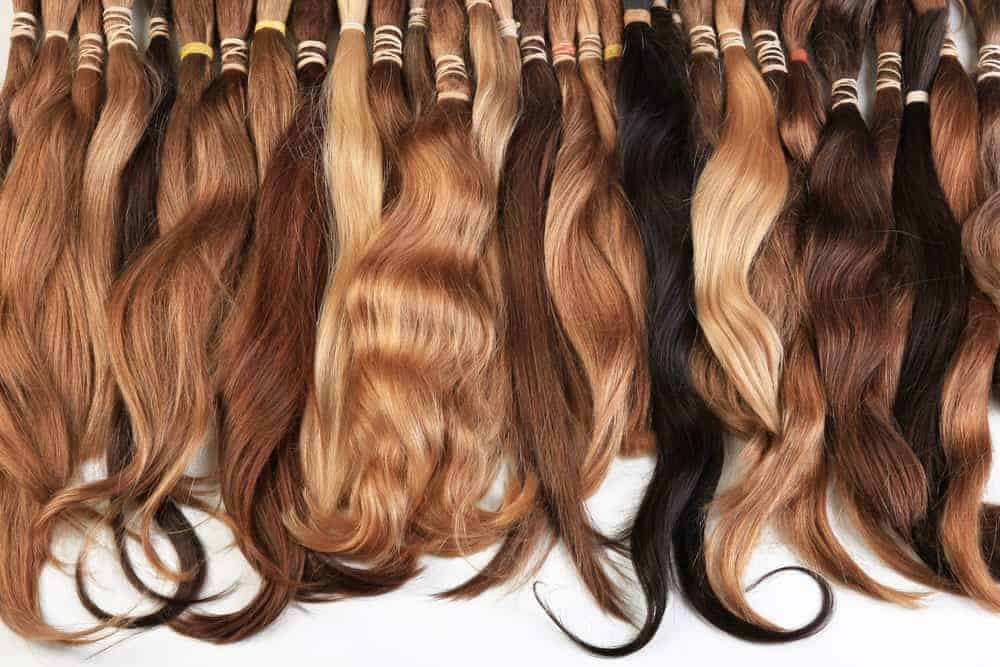
There are many reasons to choose to wear hair extensions. One of my friends from college utilized hair extensions to get the perfect look for her wedding. Adding luscious locks can add spice to a look for a party or special occasion. This temporary option can add some fun to your hair.
For some, a full head of hair or long hair has always been hard to obtain, while others are dealing with hair loss from cancer, disease, or drug side effects. No matter the motivation, if you have short hair, long hair, thick hair, or thin hair, are looking for something temporary or permanent, there are a huge number of options when it comes to hair extension types.
Read on to learn more about all of the types of hair extensions and see what the best choice might be for you and your hair type.
Contents
- Materials Used to Make Hair Extensions
- Different Ways Hair Extensions are Made
- Methods of Attachment
- Other Hair Extension Options to Consider
- What About a Wig?
- FAQ:
- What’s the difference between human and synthetic hair extensions?
- What are the different types of hair extensions?
- How do you take care of hair extensions?
- Can you get permanent hair extensions?
- How do you apply clip in hair extensions?
- Can you combine synthetic and natural hair extensions?
- Can hair extensions help your hair grow?
- Do hair extensions damage your hair?
- What are remy hair extensions?
- How much do hair extensions cost?
Materials Used to Make Hair Extensions
There are several materials used to make hair extensions, including real human hair, synthetic hair, and natural collagen extensions. Each material comes with its own set of pros and cons, price tag, and care routine.
Real Hair

Human hair is a popular choice for hair extensions. However, real extensions are expensive and will only last for about six months. After this time, the real hair extensions will need to be replaced. The benefits of choosing a human hair extension product are that the hair will look just like your hair. The shade and texture can match and human hair extensions can be dyed just like your real hair.
It’s also easy to style these extensions, as you can use curling irons and blow dryers just like normal. Washing can be done with your regular shampoo. Since these are made from real hair, these hair extensions will get frizzy or flat depending on the weather and bad hair days are still possible.
Synthetic Hair Extensions
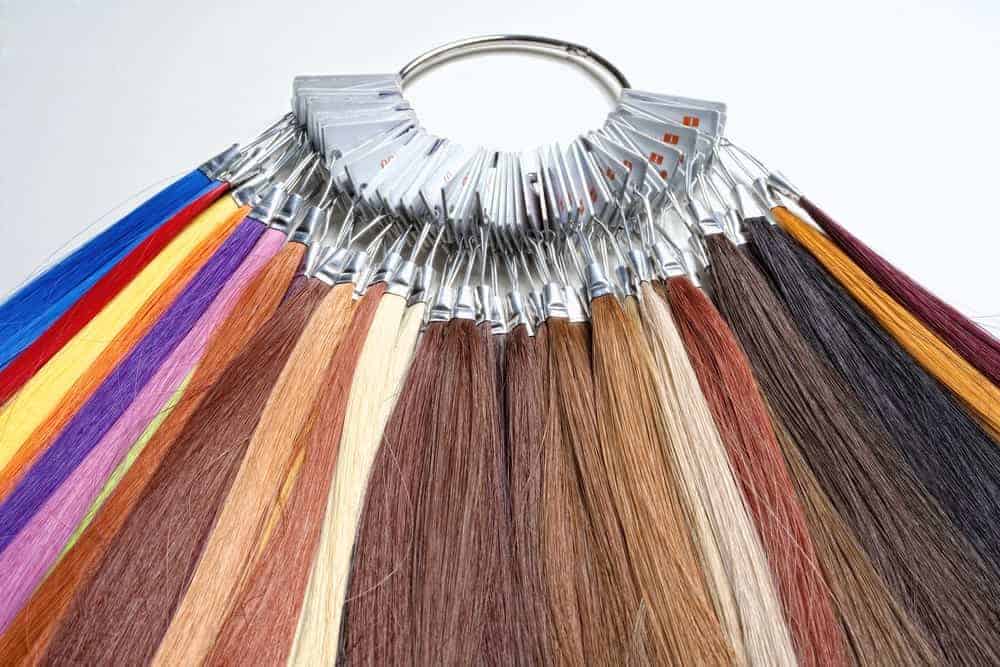
Hair extensions made out of synthetic hair cost less than those made with real hair, but will not look as natural. These extensions will also not last as long, will not perfectly match the color and texture of your own hair, and require different care than your natural hair. Taking care of synthetic hair extensions is more time consuming because they can’t be washed and treated with the same products as your real hair.
You also can’t use heat from blow dryers, curling irons, or straighteners, as these will damage the extensions. It’s also important to use a very soft-bristled brush so that the extensions are not damaged. Even though there are drawbacks, these are still a great choice for many. Synthetic extensions are ready to be worn right away and will maintain the styling that they come with. If you choose curly, wavy, or straight synthetic hair extensions, they will stay that way.
Natural Collagen Extensions

Another choice for material are extensions made from natural collagen. These types of extensions have the same qualities as human hair but are made from natural collagen protein, which is different than the keratin protein that composes natural hair.
These extensions require less maintenance than human hair and can be washed, blow-dried, curled, combed, and brushed without fear of damage. Natural collagen hair extensions are more affordable than natural hair, making them a great choice that falls between natural hair and synthetic hair.
Different Ways Hair Extensions are Made

Once you have decided upon a material for your hair extensions, you will need to decide on the construction of the extension. Some factors to take into consideration are cost, how natural they look, and what the methods of attachment are.
Strand by Strand
Strand by strand hair extensions are quite expensive because of the attachment methods and the length of time it takes to apply them. It’s important to work with an experienced professional hairstylist for attaching them to the hair and removing them, otherwise, it can be painful. This type is also not reusable and correct maintenance is a must. If these extensions are not properly taken care of, they will clump together.
Each extension will have between 20 and 40 strands of hair and will be attached to a small section of natural hair. These extensions can last for a long time with good maintenance and are great for people who have coarse or thick hair.
Wefted Panels
Wefted panels include more hair per panel than strand by strand. These can be glued, taped, or sewn in and can be removed easily. This makes them less of a commitment than strand by strand extensions. This also means that they will not last as long or be as durable. There are some types of wefted panels that need to be attached by a professional, but there are also clip-in options that can be done at home. The clip-ins are great for a style that you only need for one night for a special event or occasion.
Different Types of Wefts
Within the world of wefts, there are different types to consider. Each weft has its own benefits, costs, and downfalls.
- Hand-Tied Weft: In a hand-tied weft, all of the ends of the hair are put together and then woven together manually by hand. This makes sure that none of the strands of hair fall out. These are popular because they can remain slimmer than a weft created on a machine and will therefore be easier to hide in the hair. Those who have thin hair or are worried about their extensions being visible can benefit from choosing this type of weft. After attached (usually by sewing) the weft will not fall apart as quickly as one made on a machine might. One downfall of a hand-tied weft is that it can’t be cut. If it’s too long, it will need to be folded over and attached on top of itself. If the weft is cut, it will unravel.
- Machine Made Weft: A major advantage of a machine-made weft is that it can be cut without unraveling. This gives much more flexibility for customization. Since these are not made by hand, they will also be less expensive, thicker, and sturdier. If you need a large number of wefts for your hair, these will be a good choice. As a downside, however, since these are bulkier, they are more difficult to hide. If they are not attached correctly or by an inexperienced person, they will be more obvious. Machine-made wefts are also prone to shredding, which will look not look very good.
- Injection Molded Weft: With an injection-molded weft, you get the benefit of hair extensions that are not very visible. These can attach securely to hair without looking bulky. This makes them better for those who have thin hair or are worried about their extensions being obvious. This type of weft is generally taped and will blend nicely with your natural hair. These wefts are lightweight, which means they will be comfortable to wear for longer time periods. These wefts can also be reused. All that needs to be done is to add more tape or glue to the weft.
Methods of Attachment
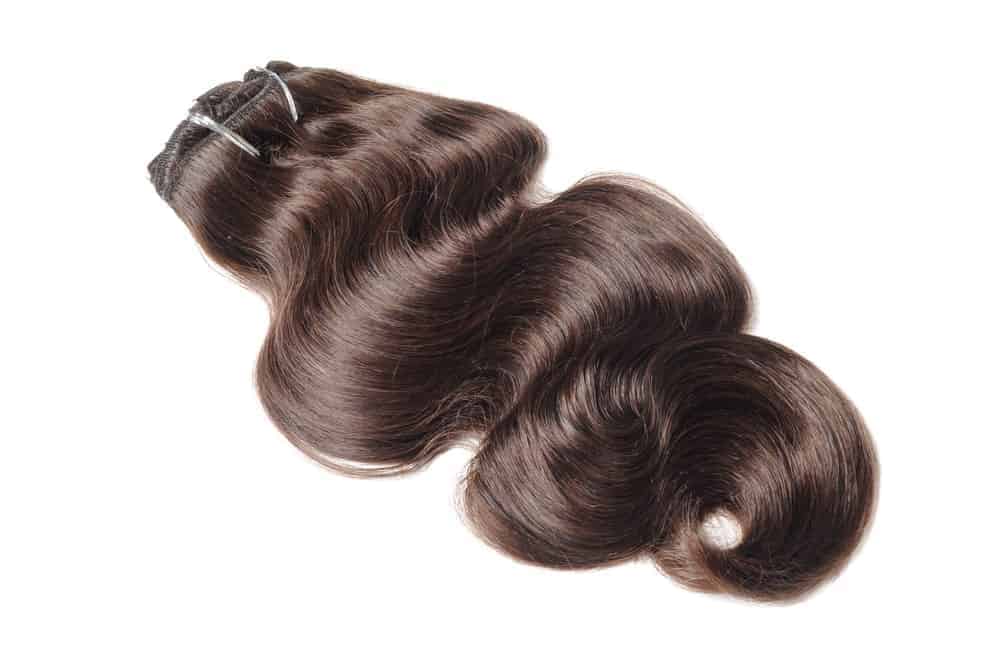
Some types of hair extensions have specific ways that they need to be attached. Others can be attached in several different ways. Speak to a professional about your options once you have chosen the material and the construction method of your hair extensions.
Clip-in Hair Extensions
It’s expensive to opt for clip-in extensions. There are many reasons for their high cost, but one of the biggest costs is taking care of them. These are the easiest hair extensions to use and are especially popular with those who wish to use the extensions to change their style without needing to go see a professional.
Clip-in hair extensions come with either a silicone or a fabric base at the part where the strands come together. This is then attached to a clip. Putting in the clip-in hair extensions yourself is easy and the process can usually be completed in about 10 minutes.
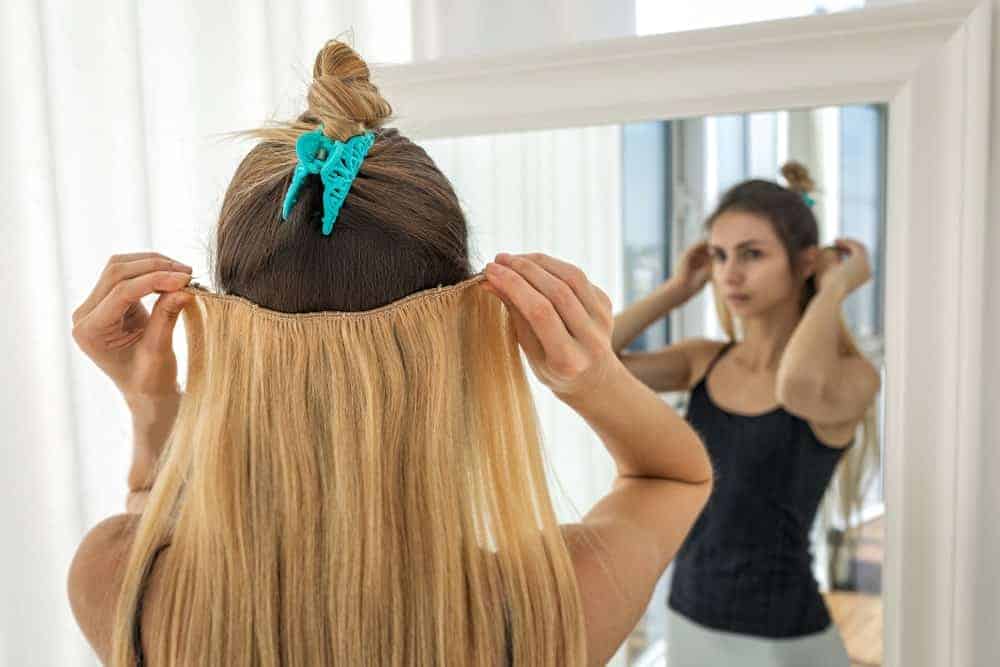
This type of temporary hair extensions should not damage hair and can last for several months, especially if not worn every day. Washing only needs to take place when dealing with product build-up, usually about every 15 wears. There are many colors to choose from and these can be used as often as you wish. However, these should be removed at bedtime and should only be used for short periods of time. Just be wary of clip-in extensions that are inexpensive, as this means that their quality will not be as high.
Tape or Glue-in
Hair that is gathered at the base of the extension and then attached is usually taped or glued in. Some extensions may have a base area that is pre-taped for easy attachment to the roots. Others may need some glue added to the weft for a secure attachment. When it’s time to have your wefts attached with tape or glue, it’s important to see an experienced professional.
It is essential that the tape extension is perfectly aligned to your roots. When seeing the professional, they will heat the tape or glue with a specialized tool that activates the tape. This will keep the extensions in the client’s hair. When you are ready to have the extensions removed, it is also best to see a professional. They will use a glue remover to get the extensions out without damaging your hair.
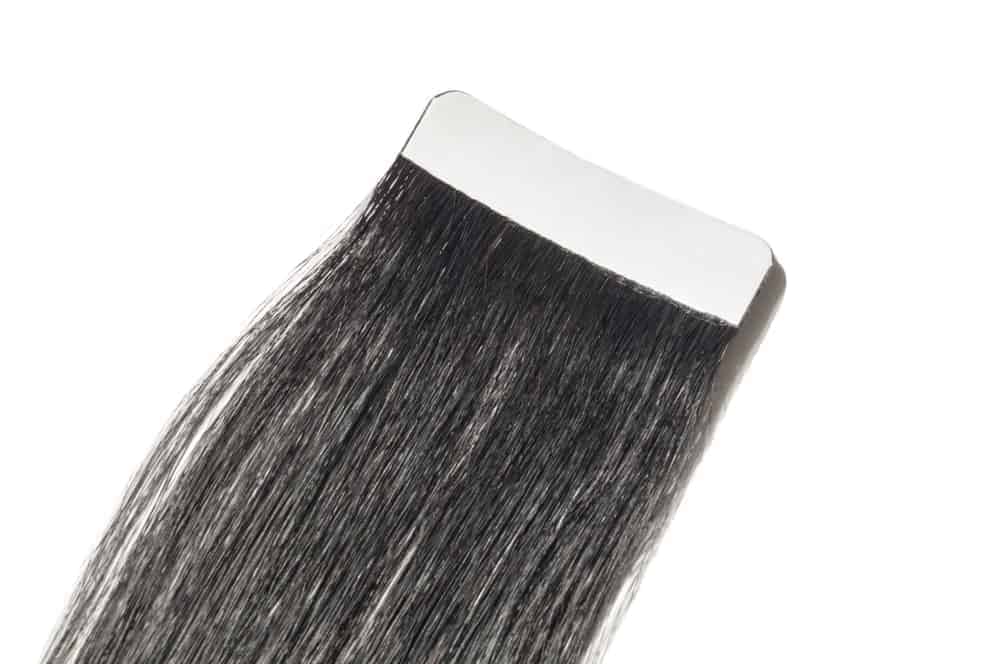
Expect to spend about an hour having extensions attached or removed when using tape or glue. This process will need to be repeated as your hair grows out, usually every four to eight weeks, because a tape hair extension will need to be continually placed by your roots. If the extensions are still in good shape, they can be used several times. Taped or glued in extensions require special shampoo and styling products that will protect the adhesive.
This type of extension is popular because the strain on your head is minimal since they are affixed near the roots, they look very natural, and application is not very complicated as long as the professional knows what they are doing. On the downside, only specific, safe products can be used on the hair. It’s also difficult to wear these extensions in an up-do.
Sewn-in
A sewn-in hair extension is basically woven into your existing hair. These weave extensions are difficult to attach and are more permanent than other types. Your natural hair will need to be braided into cornrows before the extensions are attached so that there will be a good place to work. These are usually chosen by those who have thick hair, as braiding thin hair as a base would not look very good and it’s a real possibility that thin hair would become damaged with this process.

It is an uncomfortable experience to get these weave hair extensions attached because of how tightly the cornrows need to be braided. The process also takes several hours and an experienced professional will be needed to create the best look. These extensions look very natural and there will be no worries about them falling out.
On the downside, these can stunt the growth of your natural hair, so it’s important to take them out and have them replaced on occasion. While wearing these extensions, it’s important to use special protein-enriched shampoo to minimize damage and deep conditioning products to keep your own hair healthy. In general, these extensions are made out of human hair since they are made to stay in for more than three months.
Micro Links
Micro links are attached by looping a natural hair strand through a bead, which has the extensions attached to it. Once looped through the bead, it’s clamped shut with pliers. If you go this route, make sure that you purchase the extensions from a reputable company, as low-quality beads can damage your hair. The best beads are lined with silicone, which will help to prevent your hair from breaking.
It’s expensive to have these extensions added to your hair because of how long it takes to attach each individual bead to your hair. However, this is also one of the most natural-looking types of hair extensions. The location of the bead can also be readjusted by a stylist and there are no glues or heat used in the process.
The application will take several hours and this type of extension is best for those with thicker hair. The beads will show through on thinner hair. Be sure to work with someone with lots of experience when having micro links attached. If the beads are not put in the correct place, they can be painful to sleep on or can damage the hair if the beads are not closed the right way.
Bonded Hair Extension
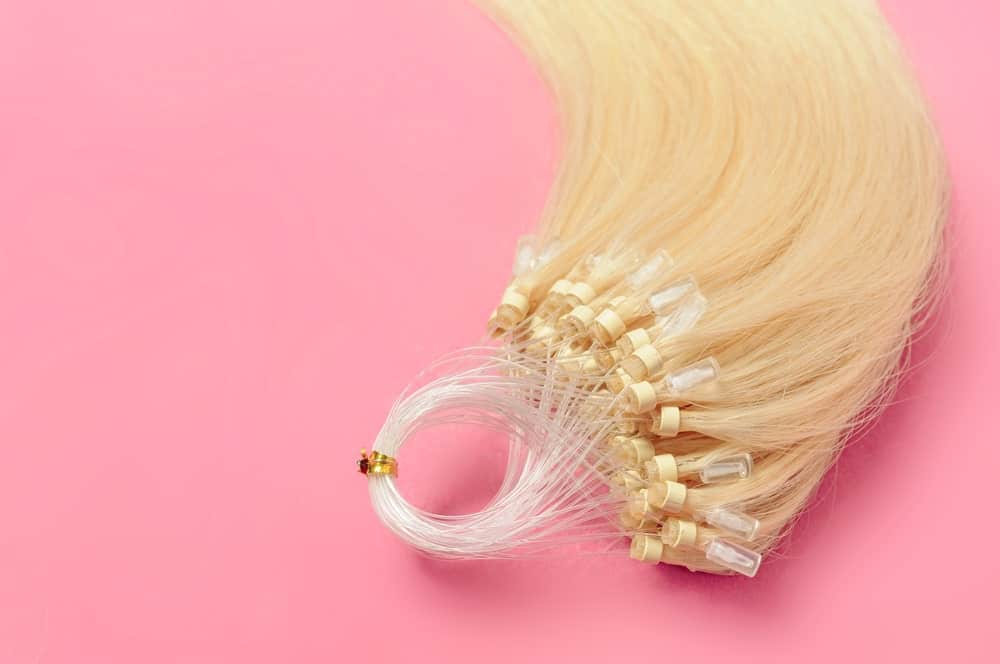
Also known as a fusion hair extension, bonded hair extensions are attached to your natural hair using adhesives. There are a few different adhesives that can be used, making it very important to find a solid professional who can help you choose the right one for your needs. The process of attachment will take close to four hours.
The stylist will use a machine that looks similar to a hot glue gun to attach the fusion extensions to single strands of hair. These extensions look very natural, but also have a tendency to damage natural hair. There is a second, similar method that clamps the extension to the natural hair, allowing the glue to melt and bind the natural hair and extension together. These will last around four months, making them a semi-permanent option. The extensions can only be used once. If you are interested in this method, also ask your stylist about a pre bonded hair extension.
Cold Fusion
Cold fusion hair extensions are similar to bonded hair extensions, but there is no heat involved. They use a clamping tool. This type looks very natural but is costly because it takes a long time to attach them and they can only be used one time. Some people experience headaches or an itchy scalp when using this type of extension.
Other Hair Extension Options to Consider

As with most things, over time new products and advancements are made. Check out these options that are new, or just a little different than traditional hair extensions. Depending on your needs, some of these options may work better for you.
Halo Hair Extension
A new method of extending hair, hair halo extensions, make the hair appear fuller and longer with a totally different application method. A wire device with the hair extensions attached is placed around the crown of the head. The surrounding hair is pulled over the wire, which makes it so it can’t be seen. The wire device is comfortable and natural hair will not be damaged since nothing is directly attached to the hair. This helps to keep natural hair healthy.
Clip-in Bangs

An easy way to add bangs to your look without the fuss of a cut is clip-in bangs. This product requires no risk as it is easy to place and easy to remove. All you have to do is find the product that best matches your hair color and best represents the style you are looking for. Clip-in bangs can be found in both natural hair and synthetic hair.
Hair Blending Extensions

Hair blending extensions are some of the highest quality extensions that you can buy. They can’t be detected and will not damage the hair or scalp. There is no anchoring involved, the base of the extension simply allows the underlying hair to glide through the extension hair.
Once the hair is blended, it’s easy to style and there are no worries about areas of the open scalp or the wind dislodging the extension. These are very comfortable to wear and colors are blended to enhance the natural hair color and complexion of the person wearing them. No salon maintenance is required.
Micro Ring Loop Hair Extensions

A version for someone who hopes to attach their extensions themselves, micro ring loop hair extensions can be attached in about 10 minutes. A cold fusion process is used, with a strand of hair being separated and pulled through a microbead, which is then clamped. These extensions are usually made of human hair and can be found in a variety of colors, styles, and lengths. The microbeads are invisible and these extensions last several months before needing to be removed.
What About a Wig?

If all of this information is making your head spin and you are feeling worried about the cost, the time, and the fact that there are few options for permanent hair extensions, it might be a good idea to think about a wig. A wig might be the best choice, especially if you have very fine hair, thin hair, or suffer from major hair loss.
People have looked to wigs for centuries and modern-day advancements make them more natural-looking, comfortable, and durable than ever. Wigs can be adjusted for any face or head shape and can cover all cosmetic flaws caused by health-related conditions. Wigs are available in natural or synthetic hair and in a variety of styles and colors. Find one to match your own color and regular style or opt for something completely new. The possibilities are endless.
FAQ:
What’s the difference between human and synthetic hair extensions?
Synthetic hair extensions are cheaper than human hair, but do not last as long, can’t be dyed or styled with heat tools, and need to be cared for differently than a human hair. Artificial hair extensions are also sensitive to the sun. Human hair extensions can be dyed, washed normally like your own hair, and can be styled with heat tools.
What are the different types of hair extensions?
There are a huge number of types of hair extensions out there. Hair extensions can be made from real hair, synthetic hair, or natural collagen. There are also several different construction methods. These include strand by strand, wefted panels, hand-tied weft, machine made weft, and injection molded weft. In addition, there are many methods of attachment.
There is clip in, tape or glue in, sewn in, micro link, bonded, and cold fusion hair extensions. Other options include hair halo extensions, clip-in bangs, hair blending extensions, and micro loop hair extensions.
How do you take care of hair extensions?
Care for hair extensions will depend on the type of material they are made out of, how they are constructed, and how they are attached. In general, human hair extensions can be cared for much like your real hair, but synthetic hair requires specialized shampoo and care. Be sure to talk to your styling professional about the specific care instructions that are associated with your specific hair extensions.
Can you get permanent hair extensions?
The word permanent is a bit precarious when it comes to hair. There is not much that is permanent about hair, as it is constantly growing and we all get hair cuts on occasion. However, there are hair extensions that will last a long time and are considered permanent extensions.
When I-tip and weft hair extensions are combined and sewn in, the extensions can last between six and 12 months. I-tips along can last for 10 or more months. K-tips, which are also known as keratin tips or keratin bonds can last about six months. The keratin tips are attached to a heating tool. These are the longest-lasting types of hair extensions, but plenty of others can last more than a month.
How do you apply clip in hair extensions?
Clip-in hair extensions should take between 10 and 20 minutes to apply. The first step is to separate your natural hair into sections and clip most of the sections out of the way. Next, begin pushing the clips along the horizontal line of the part.
Make sure each extension is lined up just where you want it and apply pressure to secure the clip. Be sure to use the bigger wefts on the larger parts of your head and the smaller wefts on the smaller parts. Just don’t go up too high with the wefts, as there will not be enough hair present to cover them.
Can you combine synthetic and natural hair extensions?
Combining synthetic and natural hair can be done, but there are many drawbacks to doing so. These two materials have very different care needs and react differently to the environment. Therefore, it’s best to use one or the other.
Can hair extensions help your hair grow?
Wearing hair extensions can certainly help your hair to grow, but they can also damage your hair if installed or removed incorrectly. As long as hair extensions are attached and removed correctly, your natural hair can continue to grow and thrive. Wearing extensions forces you to be gentle with your natural hair and also to take good care of it, which can help it grow.
Do hair extensions damage your hair?
As long as hair extensions are properly attached and removed, they should not cause hair damage. Always be sure to work with an experienced professional when it comes to choosing the best hair extensions and also when attaching them and removing them from your hair.
What are remy hair extensions?
Remy hair extensions only use high-quality human hair, virgin hair that has not been chemically processed. The remy human hair is sorted after collection to make sure all of the cuticles are the same length. After the sorting is done, the hair is bound at the base with either silk fabric or silicon and clips are hand-sewn on to make individual wefts.
How much do hair extensions cost?
As an estimate, synthetic hair extensions will cost between $60 and $85, while human hair extensions will range from $100 to $500.
References:
Byrdie: Permanent Hair Extensions Exist—Here’s How They Work
AiryHair: The Fastest Way to Apply & Remove Clip-In Hair Extensions (2020)




